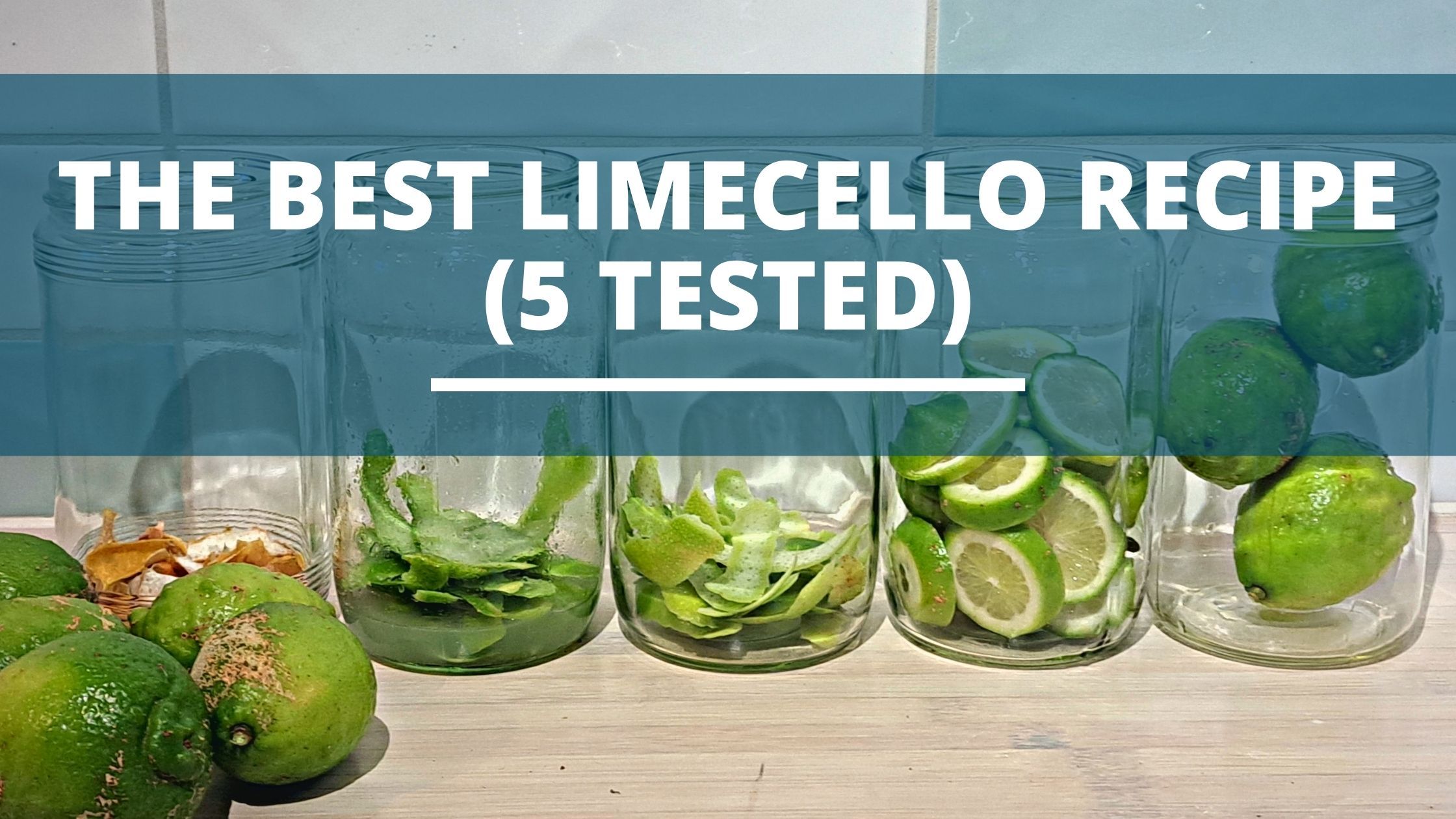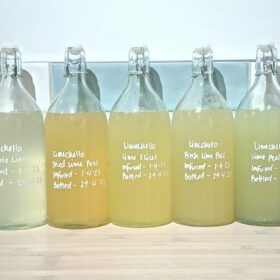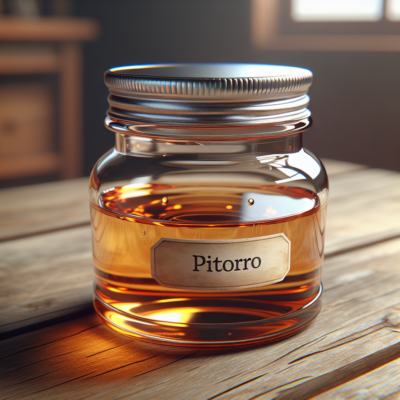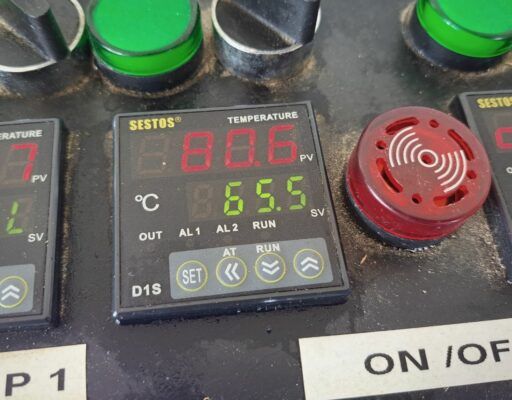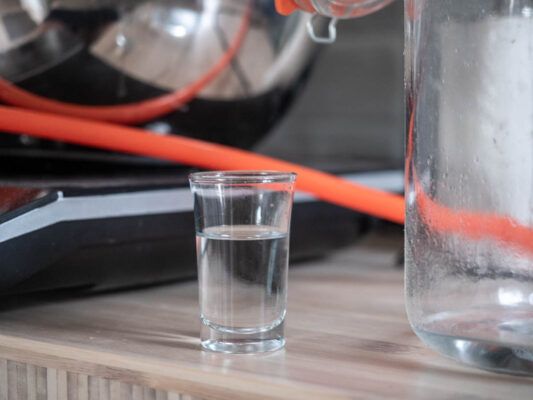Looking for a refreshing summer drink that’s easy to make? You’ve come to the right place! Limecello is a delicious variation on the classic Italian liqueur limoncello, and we’ve tested five different variations to bring you the best recipe. From dried lime zest to whole limes, we’ve tried it all, and we’re ready to share our findings with you.
The best limecello is made from the peel and juice of 3 limes. Add 200 grams of sugar, and infuse for a month with 500ml of 60% vodka. Once infused, filer through a coffee filter and add another 250ml of water to make 1L of final Limecello.
Keep reading as we share out tips and tricks to make the perfect ‘lime-cello’
Alternative: Check out our limoncello recipe here, and Arancello recipe here.
Table of Contents
First, A Brief History of Limoncello
Before we dive into our homemade limecello recipe, let’s take a moment to explore the history of its cousin and namesake, limoncello.
This sweet, tangy liqueur hails from the Amalfi Coast in Southern Italy, where it has been made for generations. Traditionally, it is served ice-cold as a digestif after a meal, but it is also a popular ingredient in cocktails.
How to Make Homemade Limecello – The Base Recipe
Making limecello is actually quite easy, and the results are well worth the effort. Here’s what you’ll need:
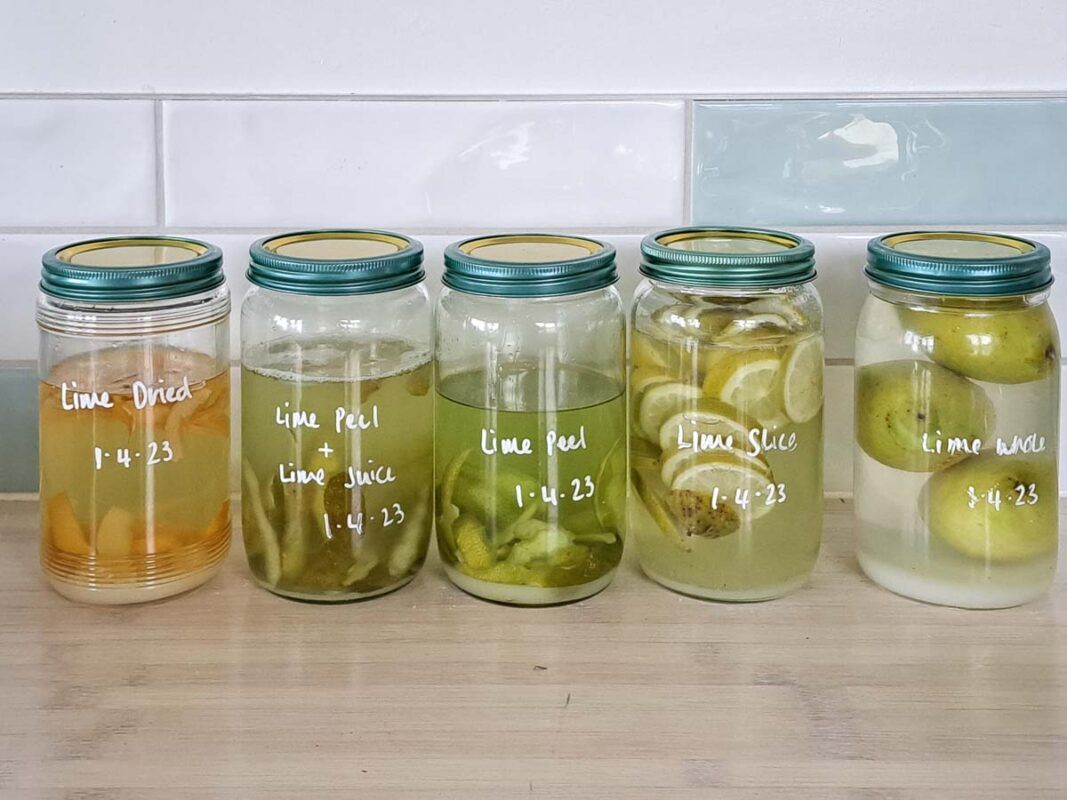
Kitchen Tools and Equipment for Making Limecello
- A large glass jar with a lid
- A vegetable peeler or zester
- A fine-mesh strainer
- A funnel
- An airtight bottle or jar for storing the finished liqueur
Ingredients for 1L of Limecello
Lemoncello is typically bottled at 28 – 32% ABV, so we want to make our limecello 30% to match.
- 3 organic limes
- 500ml of 60% Neutral Spirit (or 750 ml high-quality 40% vodka)
- 200 grams of granulated white sugar
- 250ml cups water
Note: Adjust the amount of sugar based on your desired sweetness. 200 grams is on the low side so you may want to add another 50-100 grams later if needed.
Step 1: Peel Organic Limes
The first step in making limecello is to peel the limes. Use an organic variety, as you’ll be using the zest and you don’t want any pesticides or other chemicals in your finished product. Use a vegetable peeler or zester to remove the zest from the limes, being careful not to include any of the bitter white pith.
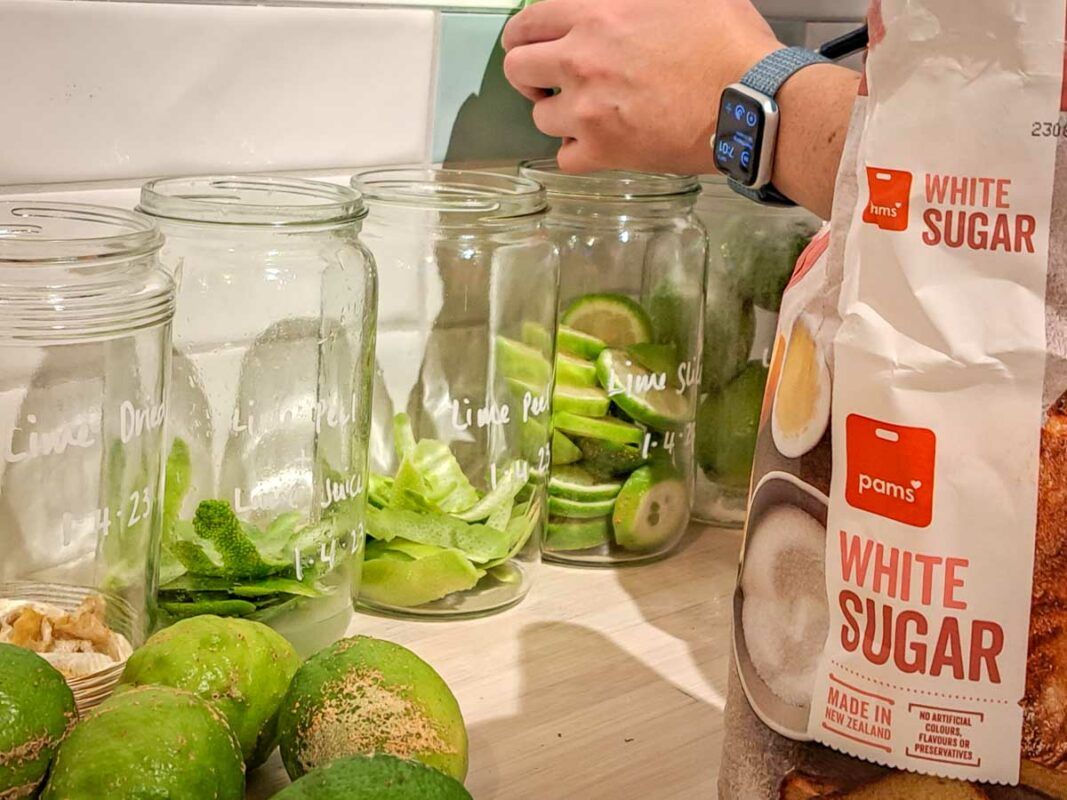
Step 2: Infuse the Lime Peels in Alcohol
Next, you’ll need to infuse the lime peels in alcohol. You can use any neutral spirit, such as vodka or Everclear, but we recommend using high-quality vodka for the best results.
There’s a bit of math to be done based on the ABV of your neutral, and the amount of water to add to get the right concentration at the end.. but more on that later.
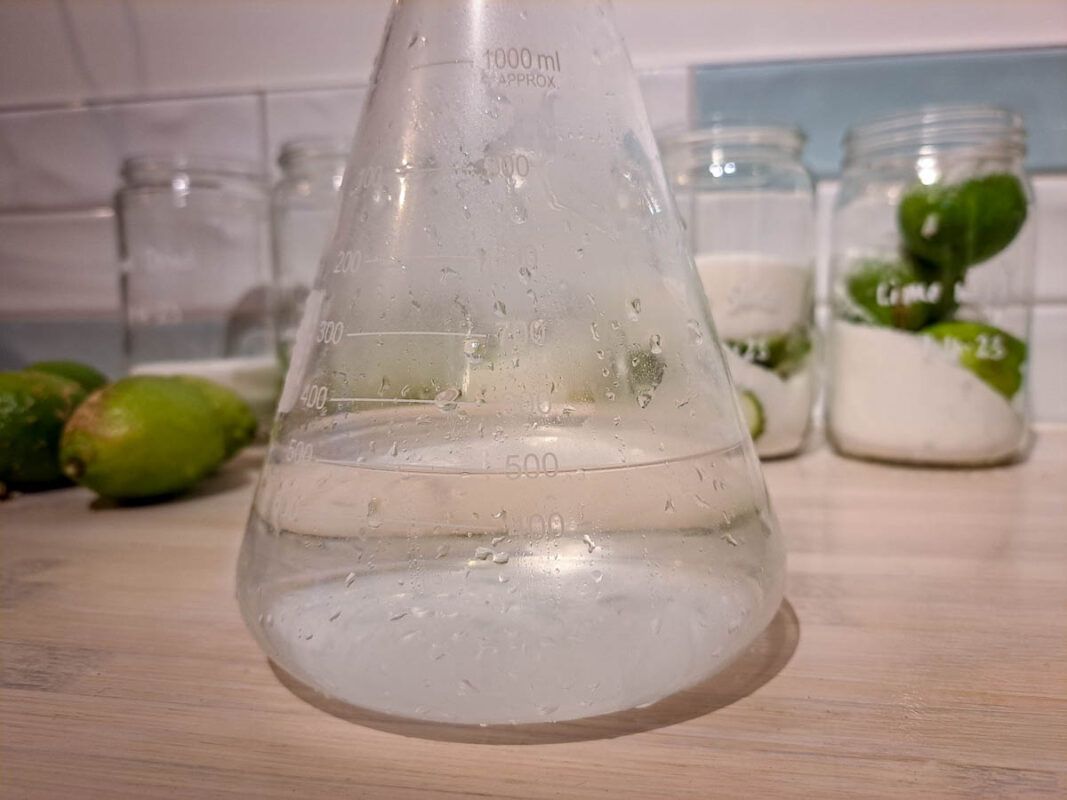
Step 3: Sweeten with Simple Syrup or Sugar
Once the lime peels have infused into the alcohol, it’s time to sweeten the mixture. You can use simple syrup or sugar, depending on your preference.
Simple syrup is easier to mix and get dissolved which may lead to a more consistent finished product, but granulated sugar is a bit easier and is the traditional way of making limoncello.
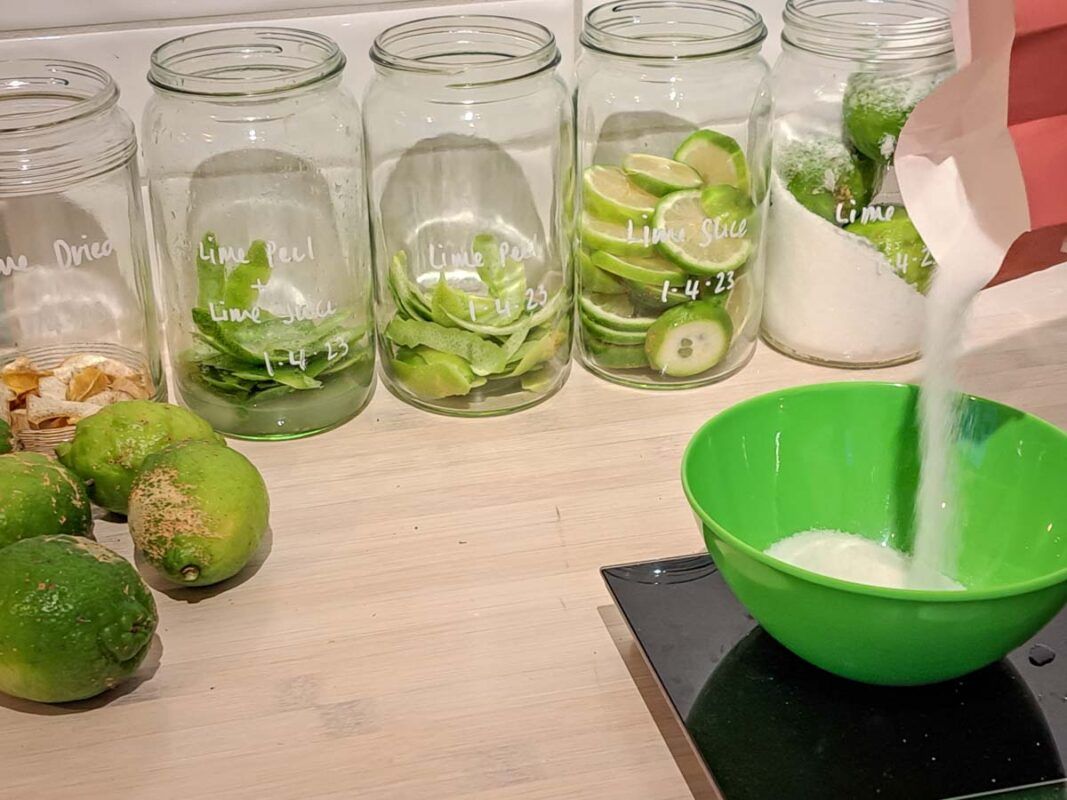
Step 4: Leave to Infuse
After you’ve added the sweetener, let the mixture sit for about a moth week or two to allow the flavors to meld together. Be sure to give it a good shake every day to keep everything evenly distributed.

Step 5: Strain and Enjoy
Finally, it’s time to strain the limecello and bottle it up for storage. Use a fine-mesh strainer to remove any solids, then transfer the liqueur to an airtight bottle or jar. Store it in the refrigerator for up to a month, or in the freezer for longer storage.
The Best Limecello Recipe
Equipment
- 1 large glass jar with a lid
- 1 vegetable peeler or zester
- 1 fine-mesh strainer
- 1 funnel
- 1 airtight bottle or jar for storing the finished liqueur
Ingredients
- 3 whole organic limes with good skin
- 500 ml of 60% Neutral Spirit or 750 ml high-quality 40% vodka
- 200 grams of granulated white sugar
- 250 ml cups water
Instructions
Step 1: Peel Organic Limes
- The first step in making limecello is to peel the limes. Use an organic variety, as you’ll be using the zest and you don’t want any pesticides or other chemicals in your finished product. Use a vegetable peeler or zester to remove the zest from the limes, being careful not to include any of the bitter white pith.
Step 2: Infuse the Lime Peels in Alcohol
- Next, you’ll need to infuse the lime peels in alcohol. You can use any neutral spirit, such as vodka or Everclear, but we recommend using high-quality vodka for the best results.
- There’s a bit of math to be done based on the ABV of your neutral, and the amount of water to add to get the right concentration at the end.. but more on that later.
Step 3: Sweeten with Simple Syrup or Sugar
- Once the lime peels have infused into the alcohol, it’s time to sweeten the mixture. You can use simple syrup or sugar, depending on your preference.
- Simple syrup is easier to mix and get dissolved which may lead to a more consistent finished product, but granulated sugar is a bit easier and is the traditional way of making limoncello.
Step 4: Leave to Infuse
- After you’ve added the sweetener, let the mixture sit for about a moth week or two to allow the flavors to meld together. Be sure to give it a good shake every day to keep everything evenly distributed.
Step 5: Strain and Enjoy
- Finally, it’s time to strain the limecello and bottle it up for storage. Use a fine-mesh strainer to remove any solids, then transfer the liqueur to an airtight bottle or jar. Store it in the refrigerator for up to a month, or in the freezer for longer storage
Notes
Our 5 Limecello Recipe Variations
While the base recipe is delicious on its own, we wanted to try some variations to see if we could improve upon it. Here are the five variations we tested:
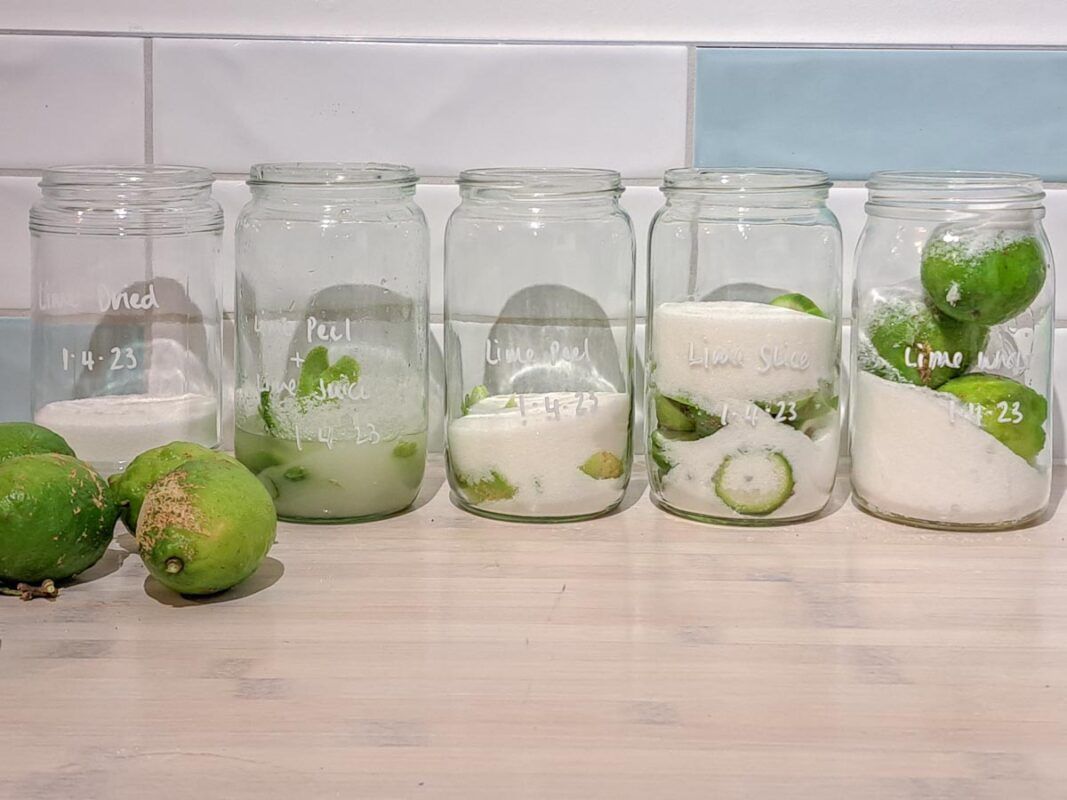
Test 1: Dried Lime Zest
For this variation, we used dried lime zest instead of fresh. The result was a slightly more muted lime flavor, but still very tasty.
Test 2: Fresh Lime Zest
This variation used fresh lime zest, and the flavor was bright and zesty. It was a close contender for our favorite variation.
Test 3: Fresh Lime Zest with Juice
We added the juice of the limes to this variation, which gave it a more complex flavor profile. It was a bit tart, but still very refreshing.
Test 4: Slices of Lime
For this variation, we added slices of lime to the mixture during the infusion process. The lime flavor was subtle, but the slices added a nice visual element to the finished product.
Test 5: Whole Lime!
Our final variation was the most experimental. We added whole limes to the mixture, peel and all, and let it infuse for several weeks. The result was a very strong lime flavor, but it was a bit bitter due to the inclusion of the pith.
What Type of Alcohol to Use in Limecello?
As we mentioned earlier, you can use any neutral spirit to make limecello. Here are the pros and cons of each type of alcohol:
Neutral Spirit
A neutral spirit, such as grain alcohol, will give you the purest lime flavor. However, it can also be quite harsh and may require more sweetener to balance it out.
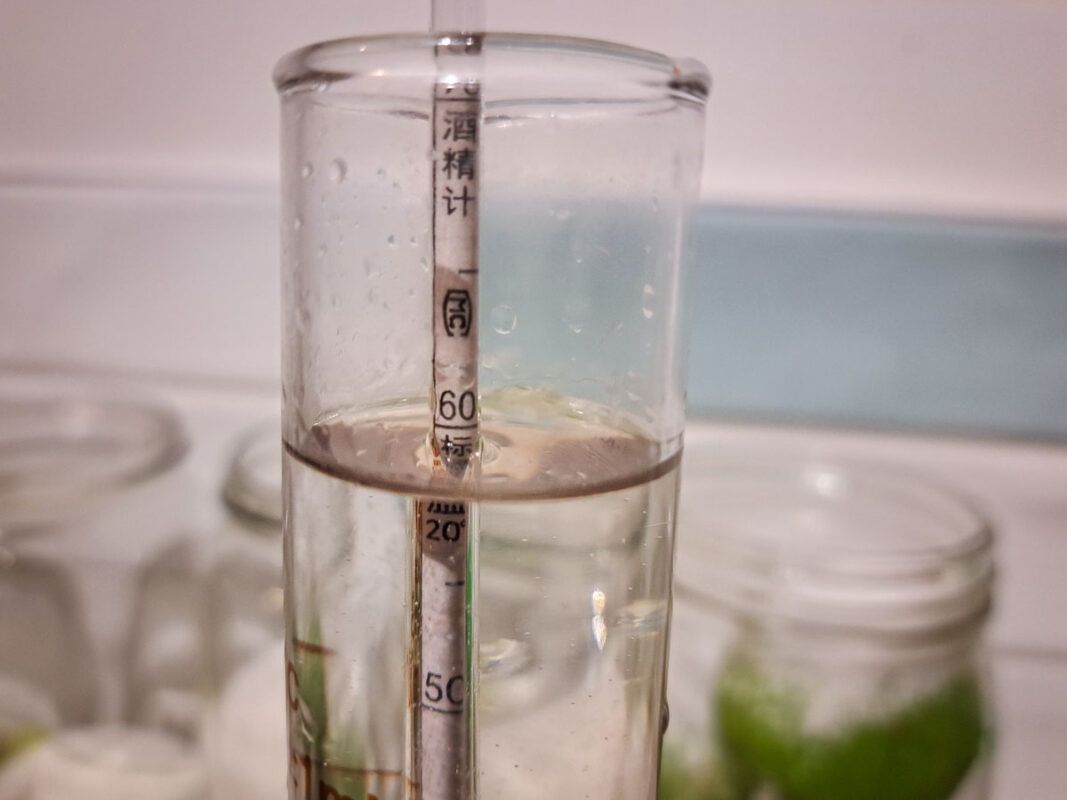
Vodka
Vodka is the most popular choice for making limecello, and for good reason. It’s smooth, easy to find, and has a neutral flavor that won’t overpower the lime.
Everclear
If you’re looking for a high-proof option, everclear is a popular choice. However, it can be difficult to find and may be too strong for some people’s tastes.
What Percentage Alcohol is Best?
The alcohol content of your limecello will affect both the flavor and the shelf life of the finished product. Here are the pros and cons of each alcohol percentage:
| Vodka Strength | Amount of Vodka | Amount of Water |
|---|---|---|
| 40% | 750 ml | 250 ml |
| 45% | 667 ml | 333 ml |
| 50% | 600 ml | 400 ml |
| 55% | 545 ml | 455 ml |
| 60% | 500 ml | 500 ml |
| 65% | 462 ml | 538 ml |
| 70% | 429 ml | 571 ml |
| 75% | 400 ml | 600 ml |
| 80% | 375 ml | 625 ml |
| 85% | 353 ml | 647 ml |
| 90% | 333 ml | 667 ml |
| 95% | 316 ml | 684 ml |
40% or 80 proof
This is the most common alcohol percentage for limecello, and it will give you a smooth, drinkable liqueur with a shelf life of about a month.
60% or 120 proof
A higher alcohol percentage will give you a stronger, more potent liqueur. However, it may be too strong for some people’s tastes.
75% or 151 proof (like Everclear 151)
This is the highest alcohol percentage you can use, and it will give you a very strong, almost medicinal liqueur. It’s not recommended for casual sipping, but it can be a good choice for making cocktails.
What Type of Sugar to Use?
You can use any type of sugar to sweeten your limecello, but we recommend using high-quality white sugar or simple syrup. Brown sugar or other flavored sugars may alter the flavor of the finished liqueur.
What Are The Best Limes to Use?
For the best flavor, use organic limes with a bright, fresh scent. Mexican or Key limes are also good choices, as they have a more complex flavor profile than regular limes.
Tip: all the flavor you’ll be infusing comes from the oil in the zest, so scratch the skin with your fingernail and smell it to tell how vibrant the flavor is.
How Long Do You Infuse Homemade Limecello?
The length of time you infuse your limecello will affect the flavor and strength of the finished product. We recommend infusing for at least a week, but you can leave it for up to a month if you want a stronger flavor.
Here is a table of infusion times based on the ABV of the vodka used:
| Vodka Strength | Infusion Time |
|---|---|
| 40% or 80 proof | 45 days |
| 60% or 120 proof | 30 days |
| 75% or 151 proof (like Everclear 151) | 14 days |
| 95% or 190 proof | 7 days |
Note that these are general guidelines, and you should always taste the mixture as you go to determine when it’s ready. The higher the ABV, the shorter the infusion time will be.
How Much Sugar Do You Add to Limecello?
The amount of sugar you add to your limecello will depend on your personal preference. Start with a small amount, and add more slowly, tasting as you go, until you achieve the desired level of sweetness. We recommend using about 1 cup of sugar per 750 ml bottle of alcohol.
Bottling and Storage
Once you’ve strained your limecello, it’s time to bottle it up for storage. Use a funnel to transfer the liqueur to an airtight bottle or jar, and store it in the refrigerator or freezer. Here are some common questions about bottling and storing limecello:
Is My Homemade Limecello Supposed to be Cloudy?
Yes, it’s normal for homemade limecello to be cloudy. This is due to the natural oils in the lime zest, and it won’t affect the flavor or quality of the finished product.
What’s the Best Way to Bottle Homemade Limecello?
We recommend using glass bottles or jars with airtight lids. Make sure they are clean and dry before filling them with your finished limecello.
Do You Have to Keep Homemade Limecello in the Refrigerator?
It’s not strictly necessary to keep your limecello in the refrigerator, but it will help prolong its shelf life. If you plan to drink it within a month or so, you can keep it at room temperature.
How Long Does Homemade Limecello Last?
Properly stored, homemade limecello can last for up to a year in the freezer. However, it’s best enjoyed within the first few months for optimal flavor.
Limecello FAQ: All Your Questions Answered
Here are some common questions about limecello, along with our expert answers:
Q. What Are The Best Limes for Limecello?
We recommend using organic limes with a bright, fresh scent for the best flavor. Mexican or Key limes are also good choices.
Q. What to Do with Limes After Making Limecello?
Don’t throw away those leftover limes! You can use the juice and pulp for cooking or baking, or make a refreshing limeade to serve with your limecello.
Q. How to Best Serve Limecello
Limecello is traditionally served ice-cold as a digestif after a meal, but it’s also a popular ingredient in cocktails. Try mixing it with soda water or tonic water for a refreshing summer drink.
Q. What’s the Best Base Alcohol/Vodka to Use?
Vodka is the most popular choice for making limecello, but you can use any neutral spirit you like.
Q. What Is Limecello Alcohol Content?
The alcohol content of your limecello will depend on the type of alcohol you use and the amount of sweetener you add. Most limecello recipes have an alcohol content of around 30-40%.
Q. How Long to Infuse Lime Peels?
We recommend infusing your lime peels for at least a week, but you can leave them for up to a month for a stronger flavor.
Q. Can I Use Other Types of Sugar?
You can use any type of sugar you like to sweeten your limecello, but we recommend using a high-quality white sugar or simple syrup.
Q. How to Store Limecello
Store your limecello in an airtight bottle or jar in the refrigerator or freezer. Properly stored, it can last for up to a year.
Q. Will Limecello Freeze?
Yes, limecello will freeze if stored at a low enough temperature but most domestic freezers aren’t cold enough. It’s common for people to keep their limoncello and limecello in the freezer.
Freeze or not it will not affect the quality or flavor of the liqueur.
Q. How to Drink Limecello
Limecello is traditionally sipped ice-cold after a meal, but it’s also a popular ingredient in cocktails. Try mixing it with soda water or tonic water for a refreshing summer drink.
Q. How to Make Limecello Cream
For a creamy twist on classic limecello, try making limecello cream. Simply mix equal parts limecello and heavy cream, shake with ice, and strain into a glass. Garnish with a lime twist and enjoy!
Conclusion
Homemade limecello is a fun and easy project that yields delicious results. Whether you’re sipping it on its own or using it in cocktails, this tangy, sweet liqueur is sure to become a summer favorite. So, grab some organic limes and your favorite vodka, and get ready to enjoy the best limecello you’ve ever tasted!

